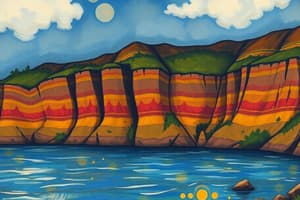Podcast
Questions and Answers
What is the thickest interior layer of Earth? The thinnest?
What is the thickest interior layer of Earth? The thinnest?
The mantle is the thickest region at about 2900 km. The crust is the thinnest, ranging from about 6 to 70 km deep.
What are Earth's core and mantle made of?
What are Earth's core and mantle made of?
The mantle is made of rock, primarily composed of heavy elements like iron and nickel in the core.
What is primitive rock?
What is primitive rock?
Any rock that has not experienced great heat or pressure.
What is igneous rock?
What is igneous rock?
What is sedimentary rock?
What is sedimentary rock?
What is metamorphic rock?
What is metamorphic rock?
What causes earthquakes?
What causes earthquakes?
What is continental drift?
What is continental drift?
How are mountains created?
How are mountains created?
What occurs during volcanic eruptions?
What occurs during volcanic eruptions?
What is the creation of the Hawaiian island chain?
What is the creation of the Hawaiian island chain?
What is the source of Earth's magnetic field?
What is the source of Earth's magnetic field?
Why is the shape of the magnetosphere not spherical?
Why is the shape of the magnetosphere not spherical?
What were the key points of Alfred Wegener's proposal for continental drift?
What were the key points of Alfred Wegener's proposal for continental drift?
List the possible interactions between Earth's crustal plates at their boundaries.
List the possible interactions between Earth's crustal plates at their boundaries.
List the principal layers of Earth's atmosphere in order of decreasing altitude.
List the principal layers of Earth's atmosphere in order of decreasing altitude.
In which atmospheric layer are almost all water-based clouds formed?
In which atmospheric layer are almost all water-based clouds formed?
What is the most abundant component of Earth's atmosphere?
What is the most abundant component of Earth's atmosphere?
In which domain of living things do you find humankind?
In which domain of living things do you find humankind?
Describe three ways in which the presence of life has affected Earth's atmosphere.
Describe three ways in which the presence of life has affected Earth's atmosphere.
Briefly describe the greenhouse effect.
Briefly describe the greenhouse effect.
How do impacts by comets and asteroids influence Earth's geology, atmosphere, and evolution of life?
How do impacts by comets and asteroids influence Earth's geology, atmosphere, and evolution of life?
Why are there so many impact craters on the Moon and so few on Earth?
Why are there so many impact craters on the Moon and so few on Earth?
Detail some of the anthropogenic changes to Earth's climate and their potential impact on life.
Detail some of the anthropogenic changes to Earth's climate and their potential impact on life.
Flashcards are hidden until you start studying
Study Notes
Earth's Layers and Composition
- The mantle is Earth's thickest layer at approximately 2900 km, while the crust is the thinnest, ranging from 6 to 70 km.
- The mantle consists primarily of rock material from the upper mantle, ejected during volcanic activity.
- The core comprises heavy elements, mainly iron and nickel, which are inferred from seismic wave analysis and planetary formation studies.
Types of Rocks
- Primitive Rock: Remains unchanged from original materials of the solar nebula; not subjected to significant heat or pressure.
- Igneous Rock: Formed through the cooling and solidification of molten material.
- Sedimentary Rock: Created by the deposition and cementing of particles, including igneous rock fragments and biological remains.
- Metamorphic Rock: Formed by the alteration of rocks under high pressure and temperature without melting.
Geological Phenomena
- Earthquakes: Result from the sudden release of built-up stress as tectonic plates interact.
- Continental Drift: Describes the gradual movement of Earth’s plates over time.
- Mountain Building: Occurs when two continental masses collide, leading to one being forced below the other.
- Volcanic Eruptions: Occur when pressure from magma leads to the upward movement of lava through the crust.
Earth's Magnetism
- Earth’s magnetic field is generated by the rotation and circulation of its iron and nickel core.
- The magnetosphere is non-spherical; it is compressed by solar wind particles from the Sun, elongating away from it.
Wegener's Continental Drift Theory
- Alfred Wegener proposed continental drift based on the fitting shapes of coastlines, shared animal species, and similar fossils found on separate continents.
Plate Interactions at Boundaries
- Plate interactions include rift zones (pull apart), subduction zones (one sliding over another), transform faults (siding past each other), and collision leading to mountain formation.
Atmospheric Layers
- The atmosphere's layers in decreasing altitude are: ionosphere, mesosphere, stratosphere, and troposphere.
- Most water-based clouds form in the troposphere, the lowest atmospheric layer.
- Molecular nitrogen (N2) constitutes 78% of Earth's atmosphere.
The Role of Life in Atmospheric Composition
- Photosynthetic organisms, like blue-green algae, increased atmospheric oxygen by consuming CO2 and producing oxygen.
- The proliferation of plants eventually formed the ozone layer, while increased CO2 from human activities contributes to climate change.
Greenhouse Effect
- Sunlight warms Earth's surface, reradiating as infrared heat, which greenhouse gases in the atmosphere trap, resulting in higher surface temperatures.
Impacts of Celestial Bodies
- Comet and asteroid impacts can create explosive events, altering Earth's geology, atmosphere, and causing mass extinctions.
- Early life forms adapted to extreme conditions following such impacts, and extinction events affected future species evolution.
Moon vs. Earth Impact Craters
- The Moon has numerous visible impact craters due to lack of geological activity, atmosphere, or water; Earth erases such evidence through constant environmental changes.
Anthropogenic Climate Change
- Human-induced emissions of CO2 raise global temperatures, leading to significant effects like the melting of glaciers and polar ice, threatening ecosystems and biodiversity.
Studying That Suits You
Use AI to generate personalized quizzes and flashcards to suit your learning preferences.


